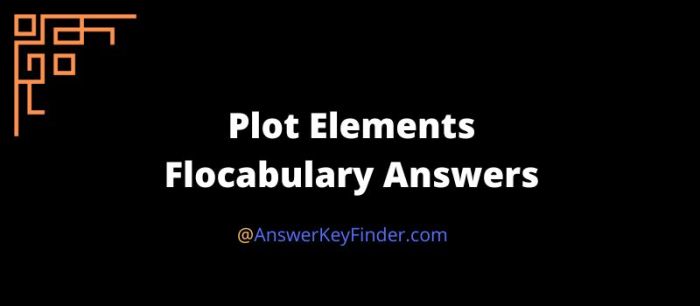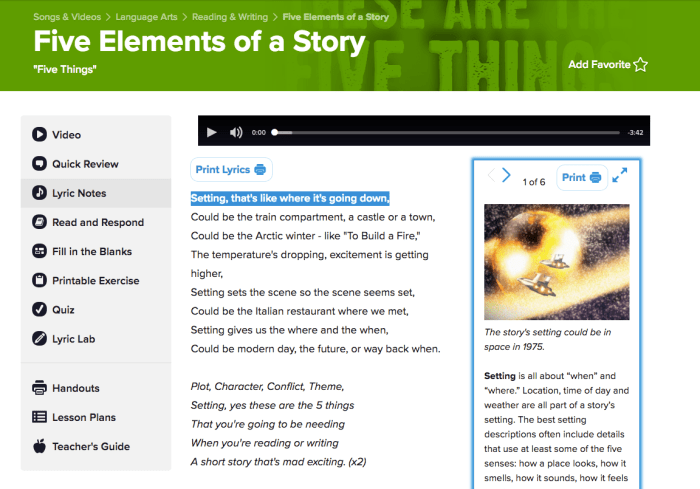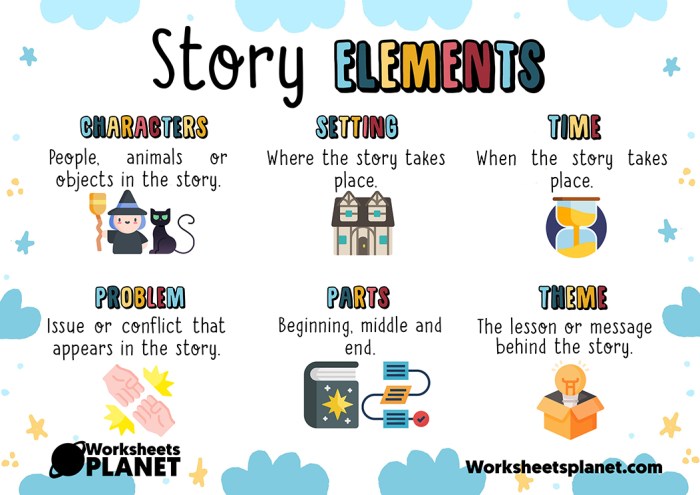Flocabulary five elements of a story – Embark on a literary journey with Flocabulary’s Five Elements of a Story. This comprehensive guide unveils the fundamental components that shape compelling narratives, empowering writers to create captivating tales that resonate with readers.
From character development to plot structure and beyond, Flocabulary’s framework provides a roadmap for crafting immersive stories that leave a lasting impact.
Flocabulary’s Five Elements of a Story
Flocabulary’s Five Elements of a Story provide a framework for understanding the essential components of any narrative. These elements work together to create a compelling and engaging story that resonates with readers or viewers.
Characters
Characters are the individuals who drive the story forward. They possess unique traits, motivations, and backgrounds that shape their actions and interactions. Characters can be protagonists (main characters), antagonists (opposing forces), or supporting characters who provide depth and complexity to the plot.
Examples:
- Harry Potter (protagonist) in the Harry Potterseries
- Darth Vader (antagonist) in the Star Warsfranchise
- Hermione Granger (supporting character) in the Harry Potterseries
Setting
Setting refers to the time, place, and environment in which the story takes place. It provides the backdrop for the characters’ actions and influences the atmosphere and tone of the narrative.
Examples:
- Hogwarts School of Witchcraft and Wizardry (setting) in the Harry Potterseries
- Victorian England (setting) in The Picture of Dorian Gray
- The Wild West (setting) in True Grit
Plot
Plot refers to the sequence of events that make up the story. It includes the introduction, rising action, climax, falling action, and resolution. The plot provides the structure and direction of the narrative, keeping readers or viewers engaged and invested in the outcome.
Examples:
- The quest for the Sorcerer’s Stone (plot) in the Harry Potter and the Sorcerer’s Stone
- The struggle between good and evil (plot) in The Lord of the Rings
- The journey of self-discovery (plot) in The Alchemist
Theme
Theme refers to the central message or idea that the story conveys. It is the underlying purpose or meaning that gives the narrative its depth and significance. Themes can be universal, exploring human experiences and emotions, or specific to a particular time or place.
Examples:
- The importance of courage and friendship (theme) in The Hobbit
- The destructive power of racism (theme) in To Kill a Mockingbird
- The nature of reality and illusion (theme) in The Matrix
Style
Style refers to the author’s unique approach to storytelling, including their use of language, tone, and structure. It encompasses the writer’s choice of words, sentence structure, and overall narrative perspective. Style can be lyrical, straightforward, humorous, or any combination thereof, and it contributes to the overall impact and memorability of the story.
Examples:
- The lyrical and evocative prose of The Great Gatsbyby F. Scott Fitzgerald
- The concise and impactful writing style of Ernest Hemingway in The Old Man and the Sea
- The humorous and satirical tone of Candideby Voltaire
Each of Flocabulary’s Five Elements of a Story plays a vital role in creating a compelling narrative. Characters drive the action, setting provides context, plot provides structure, theme conveys meaning, and style adds depth and memorability. By understanding and utilizing these elements effectively, writers and storytellers can craft stories that resonate with audiences and leave a lasting impact.
Character Development

Character development is the process of creating well-rounded, relatable characters that drive the story forward. Characters can be static, meaning they remain the same throughout the story, or dynamic, meaning they change and grow over time.
There are many different types of characters in a story, including:
- Protagonist:The main character of the story, who typically drives the plot.
- Antagonist:The character who opposes the protagonist and creates conflict.
- Supporting characters:Characters who help or hinder the protagonist, or who provide comic relief.
- Minor characters:Characters who play a small role in the story.
To create well-developed and relatable characters, it is important to consider their:
- Motivation:What drives them to act the way they do?
- Backstory:What events have shaped their personality and beliefs?
- Personality:What are their strengths and weaknesses?
- Relationships:How do they interact with other characters?
Effective character dialogue is essential for bringing characters to life. When writing dialogue, it is important to consider:
- The character’s personality:How would the character speak in real life?
- The situation:What is the context of the conversation?
- The purpose:What does the character want to achieve through the conversation?
By following these tips, you can create characters that are believable, relatable, and memorable.
Plot Structure

Plot structure is the basic framework of a story. It determines how the events of the story unfold and how the characters interact with each other. There are many different types of plot structures, but the most common include:
Linear Structure, Flocabulary five elements of a story
In a linear plot structure, the events of the story occur in chronological order. This is the most straightforward type of plot structure, and it is often used in simple stories or fairy tales.
Episodic Structure
In an episodic plot structure, the story is divided into a series of self-contained episodes. Each episode can be read or viewed on its own, but they all contribute to the overall story arc.
Circular Structure
In a circular plot structure, the story begins and ends in the same place. This type of structure is often used to create a sense of closure or to suggest that the events of the story are repeating themselves.
Plot Devices
Plot devices are techniques that writers use to move the story forward and create suspense. Some common plot devices include:
- Foreshadowing:Hints or clues that are given to the reader or viewer about what will happen later in the story.
- Flashback:A scene that interrupts the present-day action to show an event that happened in the past.
- Cliffhanger:An ending that leaves the reader or viewer in suspense, eager to find out what happens next.
Plot devices can be used effectively to create a sense of tension and excitement in a story. However, it is important to use them sparingly, as too many plot devices can make a story seem contrived or unbelievable.
Diagram of a Story
The following diagram illustrates the flow of a story:
| Exposition | Rising Action | Climax | Falling Action | Resolution |
| Introduction of characters and setting | Events that lead up to the climax | The turning point of the story | Events that follow the climax | The final outcome of the story |
This diagram is a simplified representation of a story’s structure. In reality, stories can be much more complex, with multiple subplots and twists and turns. However, this diagram provides a basic framework for understanding how stories are structured.
Setting and Atmosphere
Setting and atmosphere are crucial elements in storytelling, as they provide the context and environment in which the characters and plot unfold. Setting refers to the physical and social environment, including the location, time period, and cultural background, while atmosphere refers to the emotional tone and mood evoked by the setting.
Importance of Setting and Atmosphere
Setting and atmosphere play a significant role in shaping the story by:
- Influencing character development: The setting can shape the characters’ personalities, beliefs, and motivations.
- Driving plot: The setting can provide obstacles, challenges, and opportunities that drive the plot forward.
- Creating a sense of place: A vivid setting can transport readers to another time and place, immersing them in the story’s world.
- Evoking emotions: The atmosphere created by the setting can elicit specific emotions in readers, enhancing the overall impact of the story.
Techniques for Creating a Vivid Setting
To create a vivid and immersive setting, authors can employ various techniques:
- Sensory details: Use vivid descriptions that appeal to the five senses, allowing readers to experience the setting through sight, sound, smell, taste, and touch.
- Historical and cultural research: Accurately depicting the time period and cultural background of the setting adds authenticity and depth.
- Figurative language: Employ similes, metaphors, and personification to create memorable and evocative descriptions.
- Character perspectives: Describe the setting through the eyes of different characters to provide multiple perspectives and highlight specific aspects.
Examples of Setting’s Influence
The setting can have a profound impact on the characters and plot, as seen in classic works of literature:
- In The Great Gatsby, the lavish mansions and opulent parties of Long Island highlight the characters’ wealth and social status, shaping their relationships and desires.
- In To Kill a Mockingbird, the racially charged atmosphere of the American South in the 1930s drives the plot and forces the characters to confront prejudice and injustice.
- In The Lord of the Rings, the vast and treacherous landscapes of Middle-earth provide challenges and obstacles for the Fellowship, testing their endurance and determination.
Theme and Message: Flocabulary Five Elements Of A Story

Theme and message play a pivotal role in storytelling, conveying the underlying ideas, values, and life lessons that the narrative seeks to communicate to its audience. The theme is the central idea or message that the story explores, while the message is the specific point or lesson that the author wants to convey to the reader.
Identifying the Theme of a Story
Identifying the theme of a story involves analyzing the narrative elements and understanding the author’s purpose. Here are some steps to consider:
- Examine the story’s characters, their motivations, and the conflicts they face.
- Pay attention to the setting and atmosphere of the story, as they can provide insights into the theme.
- Consider the plot’s development, the climax, and the resolution, as they often reveal the author’s intentions.
- Reflect on the story’s ending and how it relates to the overall narrative.
Crafting a Meaningful and Impactful Message
Crafting a meaningful and impactful message requires careful consideration and thoughtful execution. Here are some tips to enhance the message’s effectiveness:
- Ensure the message is clear, concise, and relatable to the audience.
- Use vivid imagery, sensory details, and emotional language to convey the message in a compelling way.
- Consider the story’s context and how the message fits within the narrative.
- Avoid being overly didactic or preachy; instead, allow the message to emerge naturally from the story’s events.
Commonly Asked Questions
What is the significance of character development in storytelling?
Well-developed characters drive the narrative and foster emotional connections with readers. They provide depth, motivation, and relatability, making stories more engaging and impactful.
How does setting contribute to a story’s atmosphere?
Setting creates the backdrop for the story, influencing the characters’ actions, motivations, and the overall tone. It can evoke emotions, establish mood, and provide context for the plot.
What is the role of theme in a story?
Theme is the underlying message or idea that the story conveys. It provides depth and meaning, resonating with readers on a deeper level and leaving a lasting impression.